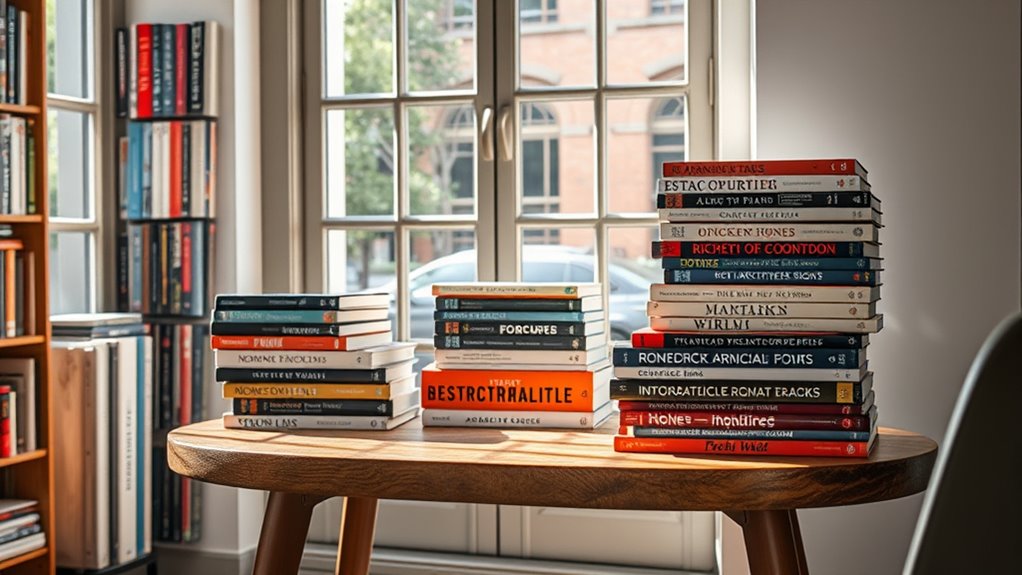If you’re looking for top-rated design inspiration, I recommend exploring 13 standout architectural books favored by leading designers. These range from classics like *Get Your House Right* and *A Pattern Language* to visual treasures like *The 99% Invisible City* and *Architecture: Form, Space, and Order*. Each offers valuable insights, stunning images, and practical ideas to elevate your projects. Keep exploring, and you’ll uncover even more ways to spark your creative flow.
Key Takeaways
- Highlight books with stunning visuals and high-quality photography that serve as inspiration for design projects.
- Recommend titles covering architectural styles, history, and fundamental principles for a well-rounded creative foundation.
- Include works by top designers and architects that showcase innovative ideas, storytelling, and craftsmanship.
- Emphasize accessible, visually rich books suitable for both professionals and enthusiasts seeking inspiration.
- Focus on books that blend aesthetic appeal with practical insights to spark creativity in architectural and interior design.
Get Your House Right: Architectural Elements to Use & Avoid

If you’re passionate about creating historically accurate or beautifully detailed homes, “Get Your House Right” is the perfect guide for you. I find it invaluable for understanding which architectural elements to emphasize and which to avoid. The book focuses on exterior features like chimneys, window casings, porches, and doors, especially in styles like Georgian, Federal, and Greek Revival. Its detailed illustrations help me recognize common mistakes and grasp proper proportions. I appreciate how it emphasizes craftsmanship, classical orders, and authenticity, making it easier to restore or build homes with genuine character. It’s a must-have reference for anyone aiming to preserve or recreate traditional architectural beauty.
Best For: homeowners, architects, and restoration enthusiasts seeking to create or preserve historically accurate and character-rich residential architecture with a focus on traditional exterior details.
Pros:
- Provides clear guidance on authentic architectural elements and proportions.
- Uses detailed, artistic illustrations to visually demonstrate do’s and don’ts.
- Emphasizes craftsmanship, classical orders, and historical accuracy for timeless design.
Cons:
- Offers limited information on interior design details and proportions.
- Focuses mainly on traditional and classical styles, with less coverage of modern or Craftsman architecture.
- Not a comprehensive resource for advanced classical architecture or interior details.
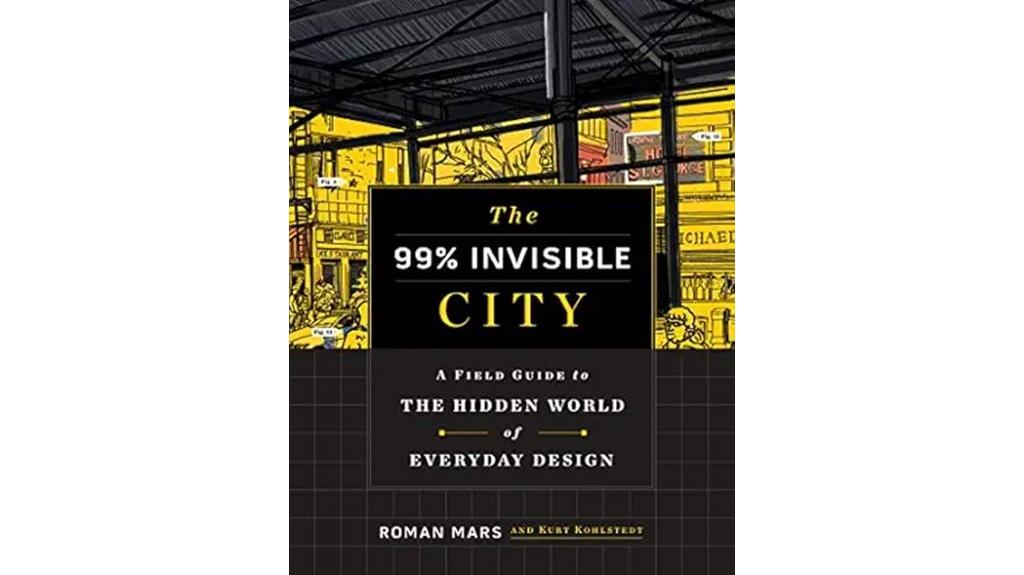
The 99% Invisible City: A Field Guide to the Hidden World of Everyday Design is perfect for curious urban explorers who want to deepen their understanding of city life through accessible, visually engaging insights. It explores overlooked urban elements, revealing how design shapes everyday experiences. Organized into clear sections, it’s easy to navigate, with fun line drawings that add style, though they’re sometimes limited in detail. While not a traditional field guide, it encourages keen observation and curiosity about city features. This book captures the spirit of the podcast, making urban exploration more insightful and inspiring for anyone interested in the unseen layers of city design.
Best For: curious urban explorers, design enthusiasts, and anyone interested in uncovering the hidden layers of city life through accessible and visually engaging insights.
Pros:
- Engaging and approachable content that appeals to a broad audience, including those with attention differences.
- Well-organized layout with clear sections, a detailed table of contents, and an index for easy navigation.
- Unique line drawings by Patrick Vale add style and visual interest, complementing the book’s theme.
Cons:
- Illustrations are sometimes crude or limited in detail, especially for complex or colorful features.
- Lack of full-color images reduces visual understanding of vibrant city elements like painted manhole covers.
- Not a true field guide; it lacks practical identification tools, making it less suitable for real-time urban exploration.
Architecture: Form, Space, and Order

Are you seeking a foundational text that clearly explains the principles of architectural composition? “Architecture: Form, Space, and Order” stands out as an ideal resource for students and professionals enthusiastic to deepen their understanding of design fundamentals. Renowned for its clear explanations, detailed illustrations, and systematic approach, it covers essential concepts like form, space, and organization. The book’s high-quality images enhance learning, making complex ideas accessible. It’s affordable on Amazon, though some buyers report receiving damaged copies despite good packaging. Overall, this book remains a highly valuable guide for anyone looking to build a solid architectural knowledge base.
Best For: students and professionals seeking a comprehensive, clear, and illustrated introduction to architectural principles and design fundamentals.
Pros:
- Highly regarded for its clear explanations, detailed illustrations, and systematic approach.
- Covers essential concepts like form, space, and organization, making complex ideas accessible.
- Well-illustrated with high-quality images that enhance understanding and learning.
Cons:
- Some buyers have received damaged copies despite good packaging.
- Occasional reports of physical defects such as ripped covers or perceived used condition.
- While affordable online, the quality control and packaging could be improved to prevent damage during shipping.
The Architecture Reference & Specification Book
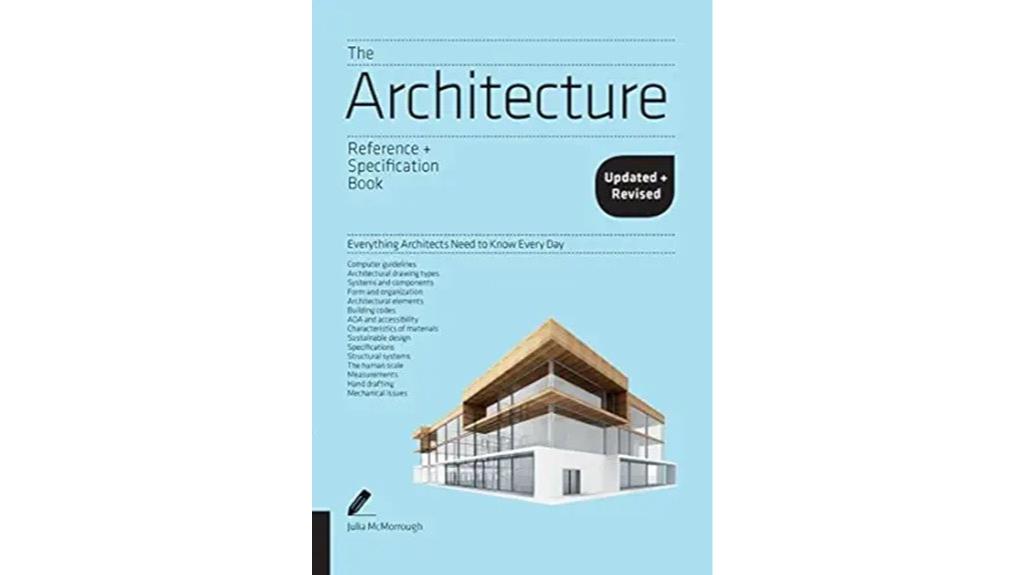
Designed with beginners, students, and non-architects in mind, the Architecture Reference & Specification Book offers an accessible overview of fundamental architectural concepts. It covers history, basic principles, building codes, sustainability, and sketching ideas, all presented with clear visuals and straightforward language. The compact design makes it perfect for quick reference or initial exploration, especially for those new to architecture or related fields. While it’s not highly technical, it provides a solid foundation and inspires visual thinking. I often recommend it for its simplicity, quality, and broad coverage—great for understanding core ideas without overwhelming detail.
Best For: beginners, students, and non-architects seeking a clear, visual introduction to fundamental architectural concepts and principles.
Pros:
- Accessible and easy-to-understand language, ideal for newcomers
- Compact design perfect for quick reference and sketching ideas
- Rich in visuals and graphical explanations that enhance comprehension
Cons:
- Lacks detailed technical drawings and advanced architectural information
- Primarily US-centric with imperial measurements, limited regional focus
- Broad coverage may require supplementary specialized or region-specific resources
How to Read Buildings: A Crash Course in Architectural Styles

If you’re an architecture student, traveler, or enthusiast keen to quickly recognize different building styles, this compact manual is your perfect companion. It offers concise, scholarly insights into architectural styles, building types, and key elements like vaults and pilasters. Its small size makes it ideal for carrying on trips or daily walks, helping you identify structures on the spot. While illustrations can be small and low contrast, the organized layout and detailed reproductions of period etchings enhance quick learning. It’s perfect for expanding your understanding of architecture, whether for educational purposes, sightseeing, or inspiring your next project. A practical, portable reference that sharpens your eye for design.
Best For: architecture students, travelers, or enthusiasts seeking a portable, quick-reference guide to recognize and understand architectural styles and building features on the spot.
Pros:
- Compact size makes it highly portable for trips and daily walks
- Well-organized with scholarly insights and detailed period etchings
- Useful for quick identification and learning about architectural styles and elements
Cons:
- Illustrations can be small and have low contrast, reducing clarity
- Some pages have dark shading that may hinder visual details
- Lacks narrative or storytelling, which might bore those seeking entertainment over information
The Interior Design Handbook: Furnish, Decorate, and Style Your Space
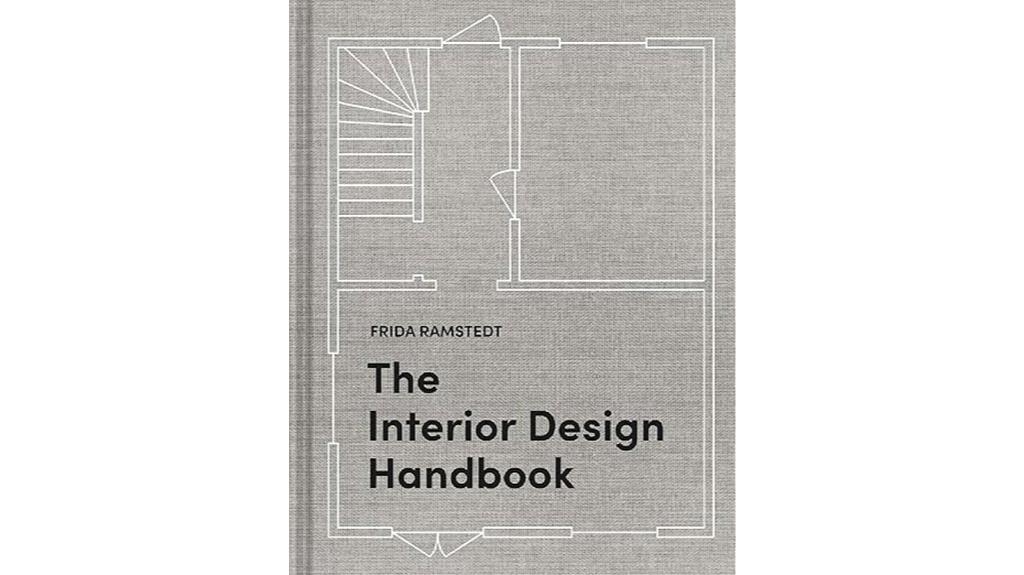
The Interior Design Handbook: Furnish, Decorate, and Style Your Space is an ideal resource for both beginners and experienced decorators seeking practical guidance without the distraction of overwhelming visuals. I appreciate how it focuses on core concepts like space feeling, layout, color, and lighting, all explained through sketches and diagrams rather than photos. Its straightforward, concise style makes understanding the “why” behind design choices easy. The book emphasizes designing based on lifestyle and budget, providing actionable tips that I can apply immediately. It’s perfect for troubleshooting, refining spaces, or building a solid foundation in interior design—without the clutter of unnecessary images.
Best For: homeowners, interior design students, and DIY decorators seeking practical, concept-focused guidance without relying on visual overload.
Pros:
- Clear, concise explanations of core design principles and reasoning
- Focus on practical tips and measurements for immediate application
- Skips overwhelming photos in favor of sketches and diagrams for better understanding
Cons:
- Lacks colorful photographs for visual inspiration
- More theoretical, which may be less appealing to those seeking quick aesthetic ideas
- Basic knowledge may be too foundational for advanced designers
Introduction to Architecture
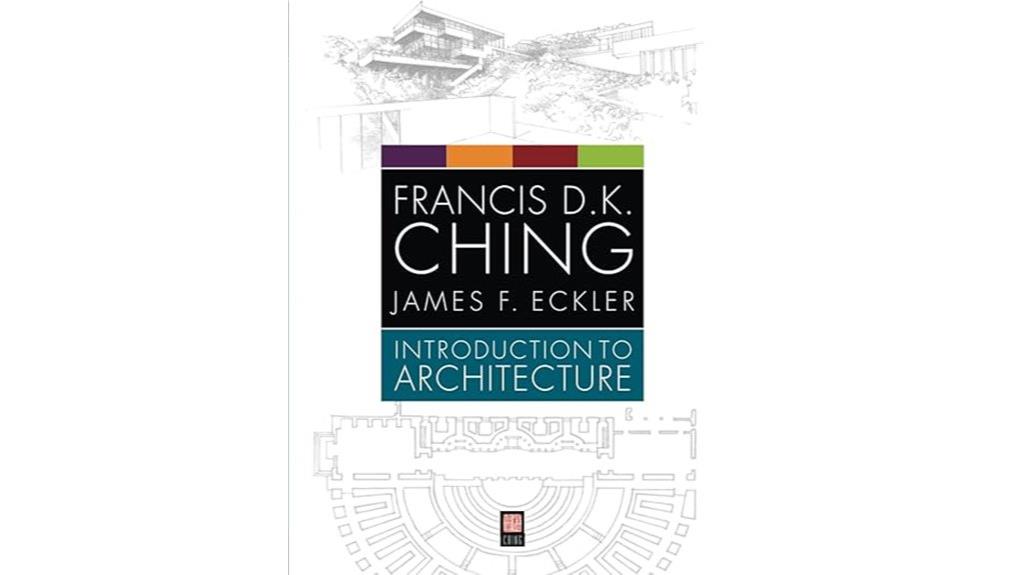
Are you looking for a thorough introduction to architecture that suits both beginners and enthusiasts? This book offers extensive content, stunning illustrations, and clear explanations that make complex ideas accessible. It’s praised for its visual appeal and usefulness for hobbyists, students, and professionals alike. The high-quality images help visual learners deepen their understanding, while the straightforward language makes learning engaging. Although some copies arrive damaged, many find the content invaluable for teaching, personal growth, or as a reference. Overall, it’s a well-regarded resource that sparks inspiration and provides a solid foundation in architecture fundamentals.
Best For: beginners, students, and architecture enthusiasts seeking a visually engaging and comprehensive introduction to architecture fundamentals.
Pros:
- Highly praised for its clear explanations and stunning, high-quality illustrations that enhance understanding.
- Suitable for a wide audience, including hobbyists, students, and professionals, making it versatile and accessible.
- Serves as an excellent teaching resource and reference for personal learning and inspiration.
Cons:
- Many copies arrive damaged with bent pages, creased edges, or torn corners, which can detract from the overall experience.
- Physical damage issues are especially frustrating given the book’s price point.
- Some buyers had to repair or return damaged copies, impacting overall satisfaction.
BIG. Yes is More. An Archicomic on Architectural Evolution
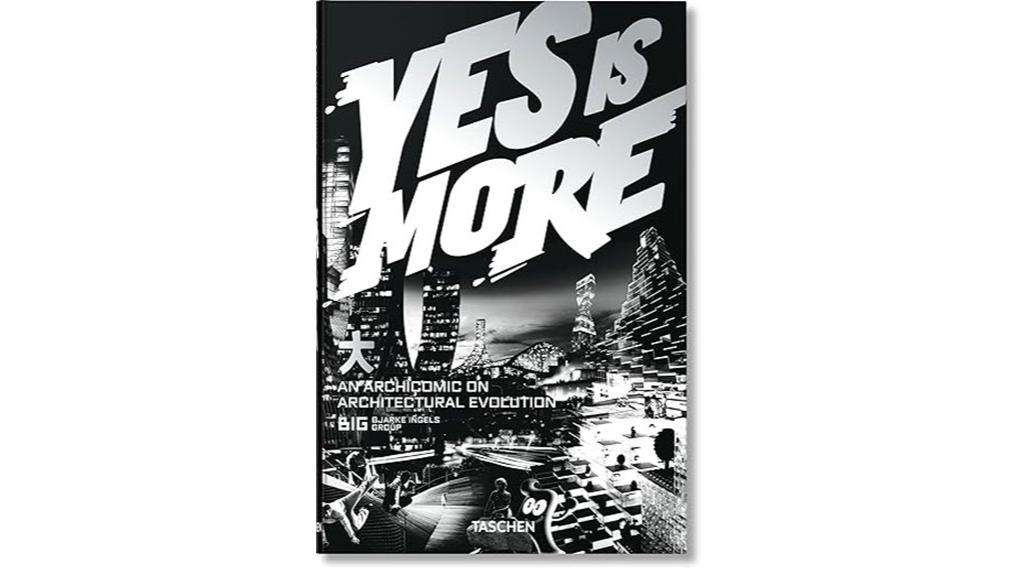
BIG. Yes is More. An Archicomic on Architectural Evolution is a mesmerizing, visually-driven exploration of how architecture develops through storytelling. I love how it uses humor, bold visuals, and a comic format to simplify complex design processes, making them accessible and engaging. The book emphasizes Bjarke Ingels’ philosophy of adaptability and evolution, highlighting how branding and economic interests influence architectural decisions. While it simplifies some technical aspects, it offers valuable insights into the strategic, iterative nature of design. Perfect for students and enthusiasts, it inspires creativity by revealing architecture’s behind-the-scenes stories and the playful, sometimes exaggerated, world of contemporary practice.
Best For: architecture students, design enthusiasts, and anyone interested in understanding the creative and strategic processes behind contemporary architecture through engaging visuals and storytelling.
Pros:
- Highly visual and accessible, making complex ideas easy to understand
- Offers an authentic glimpse into the iterative, creative decision-making process of architects like Bjarke Ingels
- Inspires creativity and provides valuable insights into branding and strategic thinking in architecture
Cons:
- Simplifies technical details, which may overlook the complexity of actual design processes
- The comic format can sometimes distort the non-linear, messy nature of architectural development
- Focuses heavily on a single architect’s perspective, limiting diversity of viewpoints
Architectural Digest at 100: A Century of Style
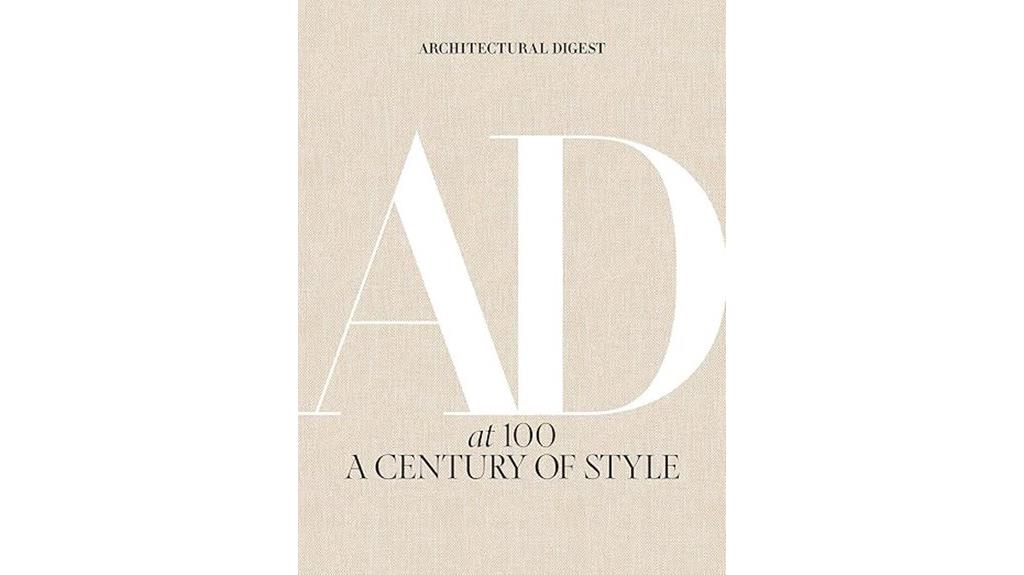
If you’re passionate about architecture and design, *Architectural Digest at 100: A Century of Style* stands out as an ideal collector’s item and source of inspiration. This beautifully crafted book features a linen cover, large vivid photographs, and stylish layouts, making it both a decorative piece and a visual feast. Its substantial size and high-quality materials elevate any space, whether on a coffee table or a shelf. Inside, inspiring images and curated content offer endless ideas for interior design enthusiasts and collectors. Many appreciate its elegance and timeless appeal, making it a must-have for anyone looking to draw inspiration from a century of iconic architectural style.
Best For: design enthusiasts, interior decorators, and collectors seeking a high-quality, inspiring centerpiece that enhances home décor with timeless architectural beauty.
Pros:
- Stunning large photographs and stylish layouts create visual inspiration and aesthetic appeal.
- Made with high-quality materials, including a linen cover, adding elegance and durability.
- Versatile for decorating coffee tables, shelves, or art walls, elevating interior spaces.
Cons:
- Heavy and large, which may be cumbersome to handle or move frequently.
- Some users have experienced damaged copies due to packaging issues during shipping.
- The high price may be a consideration for budget-conscious buyers.
Architectural Digest: The Most Beautiful Rooms in the World
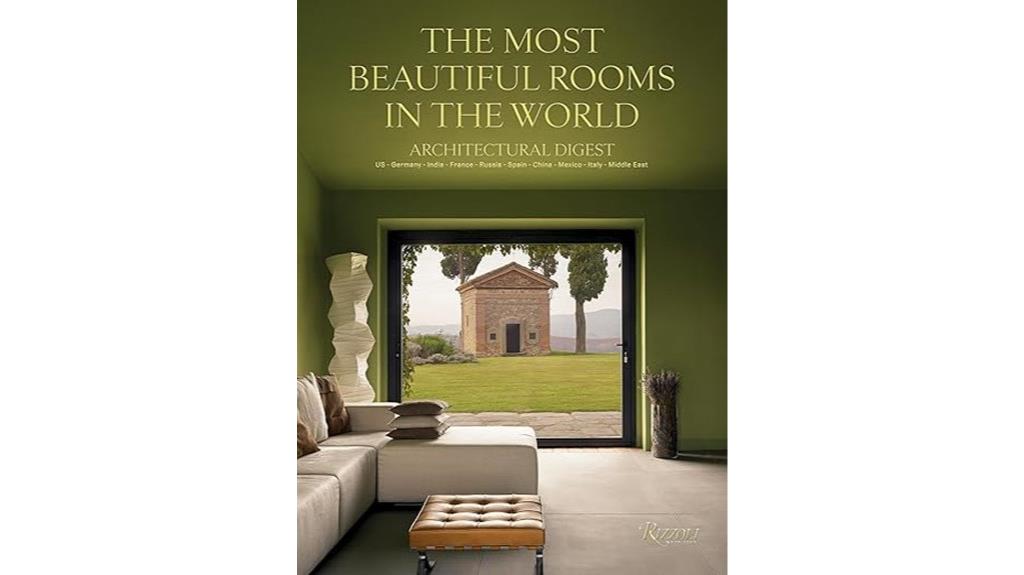
For anyone seeking stunning visual inspiration for interior design, Architectural Digest: The Most Beautiful Rooms in the World stands out as an essential resource. This gorgeous, sumptuously curated book features 321 pages of diverse, high-quality photographs showcasing breathtaking rooms from around the globe. Organized by country and style, it offers ideas for everything from bold colors to timeless elegance. I find it incredibly inspiring—whether you’re looking for fresh decor ideas or simply want to admire beautiful interiors, this book delivers. Its visual appeal and variety make it a worthwhile purchase, sparking creativity for any project or personal space.
Best For: interior design enthusiasts, homeowners seeking inspiration, and professionals looking for high-quality visual references for decorating styles.
Pros:
- Stunning, high-quality photographs showcasing a wide variety of interior styles from around the world
- Organized by country and style, providing diverse ideas suitable for different tastes and spaces
- Inspires creativity and offers practical ideas for home decorating and interior design
Cons:
- Some copies may arrive damaged, requiring replacements or refunds
- The book’s large size and weight might make it less convenient for casual browsing or portability
- As a highly curated collection, it may not feature every style or trend, limiting scope for very specific or niche preferences
Timeless: Classic American Architecture for Contemporary Living

Anyone passionate about blending timeless design with modern living will find “Timeless: Classic American Architecture for Contemporary Living” an invaluable resource. This hardcover showcases Patrick Ahearn’s exceptional work, highlighting restorations, remodels, and new builds in traditional Cape Cod style. Rich photographs and detailed stories transport you through different eras, emphasizing practicality, luxury, and craftsmanship. The vivid images of iconic homes, vintage cars, and public spaces inspire a sense of place and history. Despite minor critiques about personal touches, most readers agree the book is a stunning, educational, and inspiring tribute to classic American architecture that will influence your projects and taste.
Best For: enthusiasts, architects, and designers passionate about timeless American architecture and classic design with a modern touch.
Pros:
- Stunning high-quality photography that vividly captures architectural details and historical ambiance
- Inspiring stories and insights into restoration, remodeling, and new-build projects by Patrick Ahearn
- Rich visual storytelling that transports readers through different eras, enhancing appreciation for craftsmanship and design
Cons:
- Inclusion of personal homes and car collections may be perceived as self-promotional by some readers
- The book’s focus on traditional Cape Cod style may limit appeal to those interested in other architectural styles
- As a coffee table book, it may be more visually oriented with less technical architectural detail for professionals
A Pattern Language: Towns, Buildings, Construction
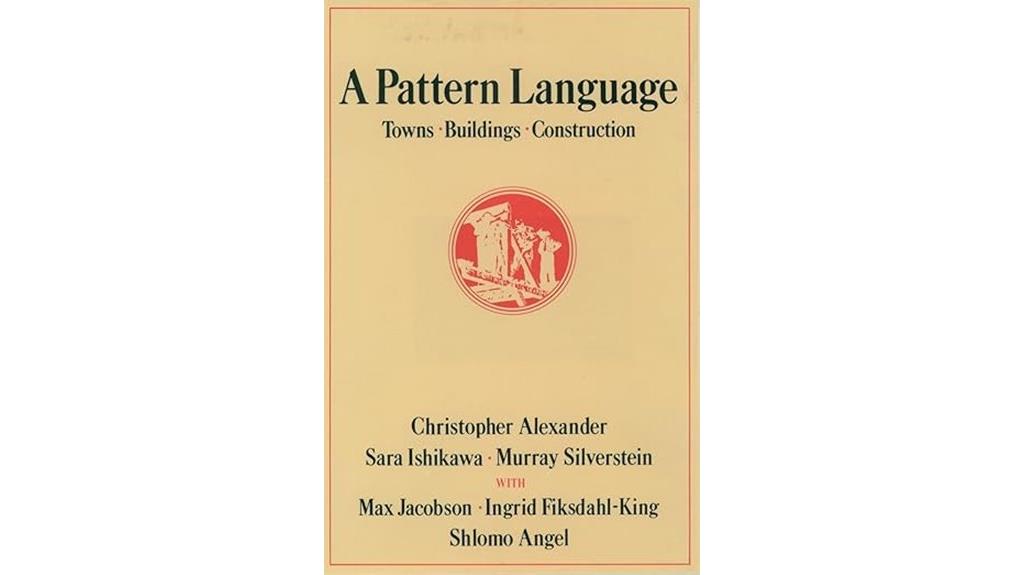
A Pattern Language: Towns, Buildings, Construction stands out as an essential guide for designers, planners, and community advocates seeking practical, human-centered solutions. Christopher Alexander’s book emphasizes sustainable, timeless design patterns that improve livability and foster community. It advocates for logical urban layouts, rainwater harvesting, edible landscaping, and shaded streets with local businesses, promoting local job creation and environmental harmony. Its accessible, pattern-based approach helps non-architects create functional, beautiful spaces. Despite being nearly 50 years old, its core principles remain relevant, inspiring designs that prioritize human well-being, community, and environmental sustainability—making it a crucial resource for anyone passionate about meaningful, resilient architecture.
Best For: individuals, community planners, and architects seeking practical, human-centered design principles to create sustainable, livable spaces and vibrant communities.
Pros:
- Provides clear, accessible patterns that are easy for non-architects to implement.
- Emphasizes timeless, sustainable design principles that enhance community cohesion and environmental harmony.
- Inspires innovative solutions for urban and residential development rooted in human well-being.
Cons:
- The book’s outdated scope, as it was written nearly 50 years ago, limits its relevance to modern technologies and urban challenges.
- Its large size and lack of an index can make navigation and quick referencing difficult.
- Some principles may seem less applicable in contemporary contexts with modern infrastructure, electronic communication, and big-box retail environments.
From the Land: Backen, Gillam, & Kroeger Architects

If you’re passionate about high-end, craft-focused architecture, “From the Land: Backen, Gillam, & Kroeger Architects” stands out as a must-have. This stunning book combines beautiful photography, detailed floor plans, and unpublished images of wineries, estates, and residences in Napa Valley. Its large format makes it perfect for coffee tables, serving as both decor and inspiration. The craftsmanship is evident, emphasizing timber framing, natural stone, and site integration. It’s a valuable resource for architects, designers, and enthusiasts alike, sparking ideas for renovation, small-scale projects, and landscape harmony. Despite minor flaws, it’s a visually impactful collection that elevates any personal or professional collection.
Best For: architecture enthusiasts, designers, and homeowners seeking high-end, craft-focused inspiration and detailed visual references for Napa Valley-inspired projects.
Pros:
- Stunning large-format photography and detailed floor plans that serve as both art and practical inspiration.
- High-quality craftsmanship and durable packaging, making it a beautiful addition to any collection.
- Offers unpublished images and unique perspectives on winery and estate architecture, sparking creative ideas.
Cons:
- The large size may be cumbersome for casual reading or everyday use.
- Minor flaws like page smudges could detract from the pristine presentation for some collectors.
- Primarily focused on Napa Valley architecture, limiting its applicability for other styles or regions.
Factors to Consider When Choosing Architectural Books to Inspire Your Next Project

When selecting architectural books for inspiration, I consider how well they match my project’s style and the quality of their visuals. I also look at the technical depth, ensuring it’s appropriate for my needs, and assess the credibility of the authors. Finally, I pay attention to layout and usability to make sure I can easily navigate and extract ideas from the book.
Relevance to Style
How do you guarantee that an architectural book truly inspires your project? The key is making certain the book’s style aligns with your desired aesthetic, whether it’s traditional, modern, or classical. Check if it covers the specific architectural period or regional style relevant to your design, providing accurate context. Look for books that highlight essential elements like proportion, ornamentation, and materials, as these details deepen your understanding and help you stay authentic. It’s also beneficial if the book showcases diverse examples within the style, broadening your creative possibilities. Finally, verify that the visual content and illustrations clearly emphasize the style’s characteristic features, making it easier to replicate or adapt the inspiration effectively. This alignment ensures your project remains cohesive and true to your vision.
Visual Inspiration Quality
Choosing architectural books with high-quality visual inspiration is essential because striking images can spark creativity and guide your design process. Look for books featuring large, detailed images that clearly showcase design elements and craftsmanship. The clarity of photographs and illustrations is crucial for analyzing proportions, materials, and stylistic details, helping you understand each project better. Well-curated layouts and consistent visual themes make it easier to compare different architectural styles and concepts at a glance. Including close-up shots and varied perspectives enhances your understanding of intricate features like joinery, ornamentation, and textures. Additionally, the use of color, contrast, and lighting in images can dramatically influence how you perceive space and detail, making top-quality visuals vital for effective inspiration.
Technical Depth Level
Selecting an architectural book with the appropriate technical depth is essential because it directly impacts how well the resource aligns with your current project needs and expertise level. If you’re working on detailed design or construction, opt for books with high technical depth that include detailed drawings, specifications, and standards—these are indispensable for professional execution. On the other hand, if you’re seeking inspiration or conceptual understanding, lower-depth books focusing on aesthetic principles or historical context are more suitable. Evaluating the technical complexity helps ensure the material matches your skill set, whether you’re a student, hobbyist, or seasoned architect. Additionally, understanding the depth level guides you in supplementing your reading with specialized references for comprehensive project development.
Author Expertise Credibility
When evaluating the credibility of an author, it’s essential to take into account their expertise rooted in both academic credentials and practical experience. I look for authors with solid backgrounds, such as degrees from respected institutions or extensive project work, which demonstrate their deep understanding of architecture. Published works that are well-reviewed and recognized by peers further establish their authority. Recognized architects or scholars affiliated with reputable firms or universities tend to bring valuable insights grounded in real-world application and research. The content’s accuracy and depth offer clues about their familiarity with architectural principles, history, and standards. Additionally, endorsements from industry experts or positive reviews serve as strong indicators that the author’s work is trustworthy and worth exploring for inspiration.
Layout and Usability
Ever wondered what makes an architectural book truly useful for inspiration? It’s all about layout and usability. A well-organized book features clear sections, a detailed table of contents, and an index, making navigation effortless. Consistent headings, subheadings, and visual hierarchy help me quickly locate key ideas. High-quality illustrations, diagrams, and sketches that complement the text boost visual learning and understanding. A compact, structured design with appropriate spacing and readable fonts keeps me engaged without feeling overwhelmed. Accessibility features like durable pages and logical sequencing improve the experience, especially when I need quick references or want to browse on the go. Ultimately, a thoughtfully designed layout transforms a book from mere pages into a practical, inspiring tool for my next project.
Content Currency & Updates
A well-organized layout makes a book easy to navigate, but choosing the right resource also means considering how current its content is. I look for books published within the last five to ten years to ensure they include the latest design trends, building codes, and technological advancements. Regular updates or series that reflect current standards are especially valuable, as they show ongoing relevance. I also review publication dates to verify coverage of recent developments like sustainable design, smart home integration, or innovative materials. Additionally, I check if the book references recent projects and case studies that address today’s architectural challenges. Older books often lack insights into digital tools, environmental regulations, or evolving aesthetics, making recent publications far more valuable for inspiration and practical application.
Readability & Accessibility
Choosing architectural books that prioritize readability and accessibility guarantees you can easily grasp complex ideas and apply them to your projects. Clear, straightforward language makes challenging concepts more approachable, ensuring you don’t get lost in jargon. Organized layouts with headings, subheadings, and summaries help you navigate content quickly, saving time. Visual aids like diagrams, photos, and illustrations complement the text, boosting understanding and inspiration. Well-structured sentences prevent overload, allowing you to focus on key ideas without feeling overwhelmed. Accessibility features such as large fonts, high contrast, and digital formats also make reading more inclusive, accommodating diverse needs. When selecting books with these qualities, you’re better equipped to absorb valuable insights and translate them into innovative, well-informed designs.
Price & Availability
The price and availability of architectural books can considerably influence your selection process. High-quality, large-format books typically range from $50 to $200, reflecting their content and production quality. Availability can vary due to supply chain issues or limited editions, making some titles hard to find or temporarily out of stock. Hardcover options with durable materials often cost more and may be limited to online or specialty stores. Digital versions and e-books offer quicker access and usually lower prices, but lack the tactile experience of printed copies. Purchasing from reputable bookstores or directly from publishers guarantees authenticity and better stock availability, especially for rare or out-of-print titles. Balancing cost, accessibility, and the experience can help you choose the best architectural books for your inspiration needs.
Frequently Asked Questions
How Do I Select the Best Architectural Book for My Project?
To select the best architectural book for my project, I focus on my specific needs and style. I look for books that feature designs similar to what I envision and offer practical insights. I also check reviews and recommendations from trusted designers. Ultimately, I choose a book that inspires me, broadens my perspective, and provides actionable ideas I can incorporate into my work.
Which Books Are Ideal for Beginners Versus Advanced Architects?
If you’re a beginner, I recommend starting with accessible books like “Architecture: Form, Space, and Order” by Francis D.K. Ching, which explains fundamental concepts clearly. For advanced architects, I suggest “Complexity and Contradiction in Architecture” by Robert Venturi, which challenges traditional ideas and offers deeper insights. Choose books based on your experience level to make sure they’re both inspiring and comprehensible, helping you grow confidently in your architectural journey.
Do These Books Cover Sustainable and Eco-Friendly Design Principles?
Absolutely, these books do cover sustainable and eco-friendly design principles—because who wants a planet that looks like a post-apocalyptic movie set? I found they explore green building techniques, energy efficiency, and eco-conscious materials, making it clear that being stylish and eco-friendly isn’t mutually exclusive. So, if you want your next project to impress both clients and Mother Earth, these are your go-to guides.
How Often Should I Update My Architectural Reading List?
I believe you should update your architectural reading list at least once a year. As design trends and technologies evolve, staying current helps me stay inspired and informed. I also add new books when I come across innovative ideas or want to deepen my understanding of specific topics. Regular updates keep my perspective fresh and guarantee I’m always learning, which ultimately benefits my projects and growth as a designer.
Can These Books Help With Specific Architectural Styles or Just General Inspiration?
Absolutely, these books are like treasure chests filled with gems tailored to specific styles and broad inspiration. I’ve found that they dive deep into particular architectural movements while also sparking fresh ideas for any project. Whether you’re into modern minimalism or historic revival, these books can serve as a roadmap or a muse — guiding your creativity and helping you understand the nuances of each style more profoundly.
Conclusion
If you’re looking to spark your creativity and elevate your projects, these books are a great place to start. They’ve inspired countless designers—and they can do the same for you. So, why not plunge in and see which ones resonate most? After all, the next masterpiece might just be a few pages away. Are you ready to turn your ideas into reality?
